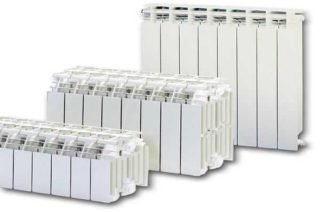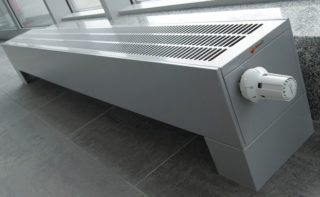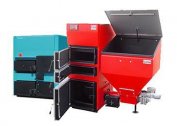Narrow heating radiators are most often used in rooms where dimensional heaters are inconvenient and take up a lot of space: in bathrooms, toilets, loggias and balconies. They create the same heating effect, provided that they are correctly installed and configured.
Scope and groups of radiators
Narrow-format heating batteries are considered alternative for different applications. This may be due to the presence of free space and design features. Such radiators are divided into horizontal and vertical.
Features of narrow horizontal batteries
Horizontal options are often used for heating narrow rooms with low walls or partitions or panoramic windows. Narrow horizontal construction suitable for loggias and balconies. This option is optimal for long rooms and corridors.
Narrow vertical models
Vertical heaters are installed on small but high partitions. Also mounted on temporary or load-bearing walls. Non-standard types of models are installed on special brackets, have an unusual shape. Such options for heaters are most often selected for an individual design.
Standard products are not always possible to fit into a modern interior. Therefore, they try to acquire models that simultaneously solve technical and artistic problems.
How to choose narrow radiators
When choosing narrow heating structures for installation at home, it is necessary to be guided by various factors. If you ignore them, you may encounter the problem of improper functioning of the structure.
- The pressure of the common heating system.
- The quality of the coolant and its type.
- Range of working temperatures of the heat carrier.
- Conducting annual hydraulic audits.
In this case, it is worth considering the material of the radiators. Often, homeowners make mistakes when choosing aluminum structures. They are very demanding on the purity of water, so they can quickly fail. For water or steam coolant, such elements are best used provided that a special system filter is installed.
Low heating radiators
Low options for heating structures are made of different materials: steel, aluminum, cast iron and other alloys. Be sure to pay attention to this when choosing a model.
Aluminum constructions
They differ in a relatively small mass, therefore, they do not require special training before installation and the involvement of a team of builders. The models are small in size, but have a high degree of heat transfer.
Steel
Most often produced in the form of tubular heating elements. Suitable for arranging heating in small height piers. The approximate bulkhead size for low tubular batteries is around 180 mm.
Bimetal options
This type is suitable for organizing heating in rooms with panoramic windows. The design with bimetallic material is characterized by high performance. It is in excellent contact with other materials. This ability is necessary when switching the heater with other elements of the heating system.
Cast iron options are most often installed in rooms where there is minimal wall insulation. Such structures have good heat dissipation, while being quite heavy and not suitable for installation in new buildings.
Operational Features
Batteries made of steel or aluminum are not always suitable for use. Aluminum is not compatible with copper elements, which are often used for plugs or as connectors and faucets. For steel, the presence of a large amount of oxygen is unacceptable, since under its influence it begins to rust quickly.
Batteries from these materials may be used in apartments, subject to all operating requirements. It is equally important to consider that it is rational to mount radiators from light and thin alloys when organizing individual heating.
Narrow radiators with high heights must be equipped with an air duct. It is installed opposite the pipeline in the upper manifold. To simplify operation, it is better to choose automatic mechanisms.
The advantages and disadvantages of narrow radiators
Narrow radiators have the following advantages:
- Suitable for universal use. Such structures can be installed near the wall, under the window or anywhere else in the room. Many of them have an aesthetic appearance.
- Good heat dissipation. Vertical radiators correspond to this parameter to a greater extent. They warm the air simultaneously in the upper and lower parts of the room.
- Good quality. Narrow radiators are reliable and tight. All joints are made with perfect durable seams. The approximate life of the radiator is 10-15 years.
- Suitable for heating rooms with a non-standard shape and area. For the space under the stairs or the cellar, such a heater will be very useful, as it fits easily into the room.
The disadvantages of this equipment:
- Installation under the window is not always possible. This is not only the most convenient area, but also quite functional. There is a fairly effective air circulation.
- High price. Instead of one narrow battery, you can buy two or three ordinary batteries. It all depends on the size and power of each. However, narrow options heat the room better.
- A small radiator needs to be flushed. This is best done twice a year: before starting and turning off the heating. Some complex structures tend to clog, resulting in air jams.
The efficiency of heating narrow heating radiators depends on the correct choice of the device and its advantages, as well as some installation features.
Dimensions of tall narrow and low convectors
Standard radiators have the following parameters: length - 93 mm, depth 140 mm, height 388 mm. Such designs have good heat dissipation if made of thin alloys. If this is a cast-iron version, the power of one section will be equal to 106 watts.
Structures that are used for heating small spaces (high batteries) have such dimensions: width 76 mm, height 661-954 mm, depth 203 mm. The operating pressure of such a heater is 10 atmospheres.
Tips for installing narrow radiators
When installing batteries under a window or on a solid wall, certain nuances must be observed.
- If installation of the structure under the window is unavoidable, initially it is necessary to find the center of the window sill, along which to measure the radiator axis.
- Consider air convection. Observe the gap between the wall and the battery. At least this gap should be 5 cm.
- If radiators with an air shutoff are installed, they must be located at a distance of at least 5 cm.
- When installing low heating radiators on the wall, it must be taken into account that the distance from the radiator must be at least 3 cm, and from the floor - 5-10 cm.
- To maintain an attractive indoor design, you can add a radiator to a pre-prepared niche. It is necessary to conduct communications to her in advance.
Radiators must be installed along each wall facing out. This significantly improves the indoor climate.
Narrow horizontal and vertical radiators are considered quite popular among users who own suburban homes. In such dwellings, heaters always justify themselves, creating warmth and comfort with ordinary energy consumption.









